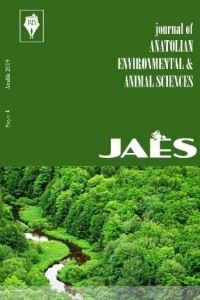Abstract
Cellulosic superabsorbents (SAP) are produced by using
cellulose and cellulose derivative blends with different binding methods,
generally. But cellulose in SAP leads
decrease in water absorption and water bonding ability because of nonreactive
character of cellulose based on its chemical structure. The oxidative
pretreatments of cellulose were attempted for the resolve of disadvantage of
cellulose in SAP, in this study. Hydrogen peroxide and TEMPO (2,2,6,6-
tetramethylpiperidine-1-oxyl) were used for oxidative pretreatments of cellulose.
Oxidized cellulose and carboxymethylcellulose (CMC) blended and cross-linked by
epicholohydrin for cellulosic SAP production. Water absorption capacity of
cellulosic SAP were determined in pH:2, 7 and 10. The results show that the
oxidative pretreatments of cellulose had affirmative effect of water absorption
capacity of cellulosic SAP according to control samples.
Supporting Institution
TÜBİTAK
Project Number
TUBITAK TOVAG 215O313
Thanks
The Authors wish to thanks to The Scientific and Technological Research Council of Turkey for financial support (Project No: TUBITAK TOVAG 215O313)
References
- Reference 1. Bao, Y., Ma, J. & Li, N. (2011). Synthesis and Swelling Behaviours of Carboxymethylcellulose-g-poly(AA-co-AM-co-MPS)/MMT Superabsorbent Hydrogel. Carbohydrate Polymers, 84, 76-82.Reference 2. Chang, C., Duan, B., Cai, L. & Zhang, L. (2010). Superaborbent Hydrogels Based on Cellulose fors Smart Swelling and Controllable Delivery. European Polymer J., 46, 92-100.Reference 3. Hubbe, M., Aguola, A., Daystar, J.S., Venditti, R.A. & Pawlok, J.J. (2013). Enhanced Absorbed Products Incorprating Cellulose and Its Derivaties: A Review. BioResources, 8(4), 6556-6629.Reference 4. Khoo, J.,M.,Y., Chee, S.Y., Lee, L.C. & Nagolingam, S. (2014). Superabsorbent Polymer Prepared Using Carboxymethylcellulose Derived Ceiba pentedra (L) Gaertn (Kapok) Cotton. Journal of Applied Polymer Science, DOI: 10.1.1002/APP.40808.Reference 5. Li, Q., Ma, Z., Yue, Q., Gao, B., Li, W. & Xu, X. (2012). Sythnhesis, Characterization and Swelling Behaviour of Superabsorbent Wheat Straw Graft Copolymers. Bioresource Technology, 118, 204-209.Reference 6. Puangsin, B., Yang, Q., Saito, T., & Isogai, A. (2013). Comparative Characterization of TEMPO-oxidized Cellulose Nanofibril Films Prepared from Non-wood Resources. International Journal of Biological Macromolecules. 59, 208– 213.Reference 7. Rémond, C., Au, B., Bry, N. & Crônier, D. (2010). Combination of Ammonia and Xylanase Pretreatments: Impact on Enzymatic Xylan and Cellulose Recover from Wheat Straw. Bioresour. Technol. 101 (17), 6712–6717.Reference 8. Saito, T. & Isogai, A. (2004). TEMPO-mediated Oxidation of Native Cellulose. The Effect of Oxidation Conditions on Chemical and Crystal Structures of The Water-insoluble Fractions. Biomacromolecules. 5(5):1983-9.Reference 9. Sannino, A., Demitri, C. & Madaghiele, M. (2009). Biodegradable Cellulose-based Hydrogel. Design and Apllications. Materials, 2(2), 363-373.Reference 10. Wu, F., Zhang, Y., Liu, L. & Yao, J..M. (2012). Synthesis and Characterization of A Novel Cellulose-g-poly (acrylic-co-acrylamide) Superabsorbent Composite Based on Flax Yarn Waste. Carbohydrate Polymers, 87(4), 2519-2525.Reference 11. Wüstenberg, T. (2015). Cellulose and Cellulose Derivatives in The Food Industry, Singapore, Wiley VCH Verlag GMBH&Co. KGaA, Germany.
Abstract
Project Number
TUBITAK TOVAG 215O313
References
- Reference 1. Bao, Y., Ma, J. & Li, N. (2011). Synthesis and Swelling Behaviours of Carboxymethylcellulose-g-poly(AA-co-AM-co-MPS)/MMT Superabsorbent Hydrogel. Carbohydrate Polymers, 84, 76-82.Reference 2. Chang, C., Duan, B., Cai, L. & Zhang, L. (2010). Superaborbent Hydrogels Based on Cellulose fors Smart Swelling and Controllable Delivery. European Polymer J., 46, 92-100.Reference 3. Hubbe, M., Aguola, A., Daystar, J.S., Venditti, R.A. & Pawlok, J.J. (2013). Enhanced Absorbed Products Incorprating Cellulose and Its Derivaties: A Review. BioResources, 8(4), 6556-6629.Reference 4. Khoo, J.,M.,Y., Chee, S.Y., Lee, L.C. & Nagolingam, S. (2014). Superabsorbent Polymer Prepared Using Carboxymethylcellulose Derived Ceiba pentedra (L) Gaertn (Kapok) Cotton. Journal of Applied Polymer Science, DOI: 10.1.1002/APP.40808.Reference 5. Li, Q., Ma, Z., Yue, Q., Gao, B., Li, W. & Xu, X. (2012). Sythnhesis, Characterization and Swelling Behaviour of Superabsorbent Wheat Straw Graft Copolymers. Bioresource Technology, 118, 204-209.Reference 6. Puangsin, B., Yang, Q., Saito, T., & Isogai, A. (2013). Comparative Characterization of TEMPO-oxidized Cellulose Nanofibril Films Prepared from Non-wood Resources. International Journal of Biological Macromolecules. 59, 208– 213.Reference 7. Rémond, C., Au, B., Bry, N. & Crônier, D. (2010). Combination of Ammonia and Xylanase Pretreatments: Impact on Enzymatic Xylan and Cellulose Recover from Wheat Straw. Bioresour. Technol. 101 (17), 6712–6717.Reference 8. Saito, T. & Isogai, A. (2004). TEMPO-mediated Oxidation of Native Cellulose. The Effect of Oxidation Conditions on Chemical and Crystal Structures of The Water-insoluble Fractions. Biomacromolecules. 5(5):1983-9.Reference 9. Sannino, A., Demitri, C. & Madaghiele, M. (2009). Biodegradable Cellulose-based Hydrogel. Design and Apllications. Materials, 2(2), 363-373.Reference 10. Wu, F., Zhang, Y., Liu, L. & Yao, J..M. (2012). Synthesis and Characterization of A Novel Cellulose-g-poly (acrylic-co-acrylamide) Superabsorbent Composite Based on Flax Yarn Waste. Carbohydrate Polymers, 87(4), 2519-2525.Reference 11. Wüstenberg, T. (2015). Cellulose and Cellulose Derivatives in The Food Industry, Singapore, Wiley VCH Verlag GMBH&Co. KGaA, Germany.
Details
| Primary Language | English |
|---|---|
| Journal Section | Articles |
| Authors | |
| Project Number | TUBITAK TOVAG 215O313 |
| Publication Date | December 31, 2019 |
| Submission Date | November 1, 2019 |
| Acceptance Date | December 10, 2019 |
| Published in Issue | Year 2019 Volume: 4 Issue: 4 |




